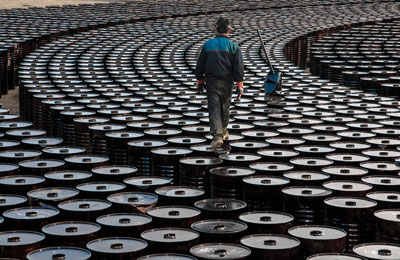An oil supply shortage may be the last thing on investors' minds right now, but the ability of Opec producers to cope with an unexpected surge in demand is diminishing fast, analysts and forecasters say.
For years, the Organization of the Petroleum Exporting Countries (Opec) has pumped much less than it can - as much as 4 million barrels per day (bpd) less than capacity - leaving lots of room for a response if there's a sudden jump in consumption.
The cartel can now pump around 33.5 million bpd, the International Energy Agency said on Wednesday, well above demand for its oil this year at around 29.5 million bpd.
But that spare capacity could halve this year, if trends persist, perhaps to as low as 1.7 million bpd, analysts say.
"A much thinner oil supply buffer could be developing," said Virendra Chauhan, oil analyst at London-based market consultancy Energy Aspects.
Opec's production has increased sharply in the last couple of months, a combination of stock building, healthy refining margins that have boosted processing throughout, and rising domestic demand from oil producers themselves.
Weak oil prices, which have halved over the last nine months, have stimulated extra demand and helped make it much more profitable to run refineries.
On top of this, some Opec members, led by Saudi Arabia, have increased production to build up market share in case Iran increases its output sharply if economic sanctions imposed on the Islamic Republic are removed this year.
"Incremental Saudi crude burn demand could push its volume this summer to levels that would substantially reduce global spare capacity, at a time when oil markets will be tighter and geopolitical risks to supply are growing," U.S. energy consultancy PIRA wrote in a report to clients.
PIRA estimates Saudi Arabia pumped around 10.3 million bpd of crude oil in March, close to a record.
Energy Aspects agrees and says Saudi oil output may have to climb to unprecedented levels this year to meet demand for overseas buyers and from domestic power stations as mid-year temperatures soar.
"In fact, this summer may see Saudi output at 11 million bpd as direct burn swings higher," Energy Aspects said in a report.
"And if non-Opec supplies start to falter by then (as a delayed reaction to prices kicks in), the focus of the market may shift to low capacity," it added.
If Saudi oil output were to rise to 11 million bpd, that would push Opec production up to around 31.8 million bpd, all other things being equal, cutting spare capacity to just 1.7 million bpd.
That could change oil market sentiment, Chauhan said.
"Should the strength in oil demand remain, and the Saudis are producing 11 million bpd, and we see volatility in output from other Opec members, the market may start paying attention to the very thin spare capacity buffer which is being ignored in the current state of oversupply." – Reuters
Analysis, Interviews, Opinions
Oil supply buffer could halve as Opec output rises

- Similar Stories

Both humans and tech must evolve as the AI era unfolds

Australian freelancers most expensive: research

5 ways AI is breaking barriers and boosting access to healthcare

Companies planning to modernise offices to woo top talent

Key factors that will drive Mobile Financial services’ growth

Make-to-Order emerges perfect paradigm for manufacturing
